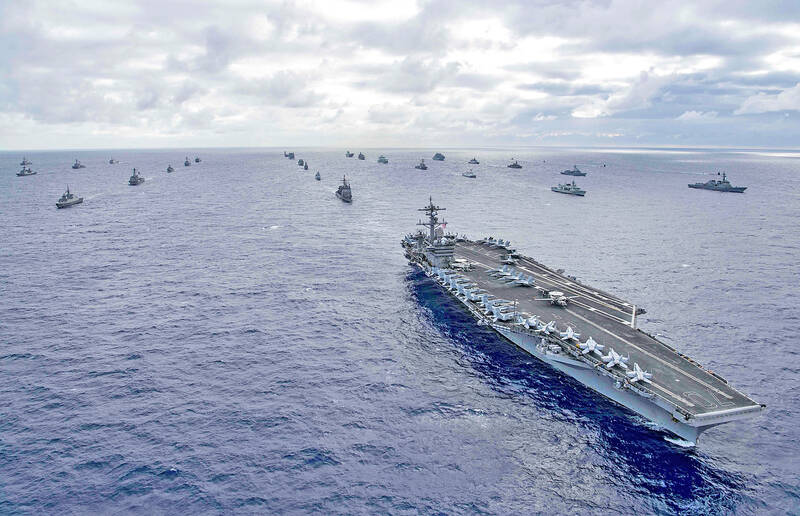The US and allied navies plan to sink a 40,000-tonne ship at the latest Rim of the Pacific (RIMPAC) exercise to simulate defeating a Chinese amphibious assault on Taiwan.
This year’s RIMPAC — the 29th iteration of the world’s largest naval exercise — involves the US, 28 partners, more than 25,000 personnel, 40 warships, three submarines and more than 150 aircraft operating in and around Hawaii from yesterday to Aug. 1, the US Navy said in a press release.
The major components of the event include multidomain warfare exercises in multiship surface engagements, anti-submarine warfare and multi-axis defense of a carrier strike group against live forces, it said.

Photo: AFP / US Navy / Dylan M. Kinee
The capstone event of the drills is the sink exercise, which is to utilize different classes of ships throughout the years, the War Zone said in a report on June 10.
This year’s target, the USS Tarawa, an amphibious assault ship, was the lead warship of its class and was designed to transport marines and support them with its complement of strike aircraft, the outlet said.
Although another Tarawa-class vessel was destroyed for target practice before, the ship’s impending demise is still important, as few opportunities exist for navies to test their weapons against a large and heavily protected target, it said.
“It [has] been a very long time since the navy used an amphibious assault ship of any kind for the RIMPAC [sink exercise], but [it] is the largest ship of any kind to be used in more than a decade,” the report said.
“Amphibious assault ships are high-value assets ... designed to be well-protected right down to their core structures and otherwise resilient to damage thanks to redundant features,” it said, adding that the USS Tarawa was more modern than the Iwo Jima-class types sunk in past drills.
The planned destruction of the USS Tarawa in the war games coincided with the Chinese People’s Liberation Army Navy’s efforts to expand its amphibious assault ship fleets, which would be “top target for US forces,” it said.
The ongoing RIMPAC exercise is meant to send China “a strong message,” analyst Richard Fisher Jr told Voice of America Cantonese.
The destruction of the USS Tarawa, the equivalent in size to China’s largest landing helicopter docks, would show the Chinese that the US Navy is capable of sinking their ships, he was cited as saying.

Taiwan is to commence mass production of the Tien Kung (天弓, “Sky Bow”) III, IV and V missiles by the second quarter of this year if the legislature approves the government’s NT$1.25 trillion (US$39.78 billion) special defense budget, an official said yesterday. Commenting on condition of anonymity, a defense official with knowledge of the matter said that the advanced systems are expected to provide crucial capabilities against ballistic and cruise missiles for the proposed “T-Dome,” an advanced, multi-layered air defense network. The Tien Kung III is an air defense missile with a maximum interception altitude of 35km. The Tien Kung IV and V

The disruption of 941 flights in and out of Taiwan due to China’s large-scale military exercises was no accident, but rather the result of a “quasi-blockade” used to simulate creating the air and sea routes needed for an amphibious landing, a military expert said. The disruptions occurred on Tuesday and lasted about 10 hours as China conducted live-fire drills in the Taiwan Strait. The Civil Aviation Administration (CAA) said the exercises affected 857 international flights and 84 domestic flights, affecting more than 100,000 travelers. Su Tzu-yun (蘇紫雲), a research fellow at the government-sponsored Institute for National Defense and Security Research, said the air

A strong continental cold air mass is to bring pollutants to Taiwan from tomorrow, the Ministry of Environment said today, as it issued an “orange” air quality alert for most of the country. All of Taiwan except for Hualien and Taitung counties is to be under an “orange” air quality alert tomorrow, indicating air quality that is unhealthy for sensitive groups. In China, areas from Shandong to Shanghai have been enveloped in haze since Saturday, the ministry said in a news release. Yesterday, hourly concentrations of PM2.5 in these areas ranged from 65 to 160 micrograms per cubic meter (mg/m³), and pollutants were

Taiwan’s armed forces have established response protocols for a wide range of sudden contingencies, including the “Wan Chun Plan” to protect the head of state, the Ministry of Defense (MND) said today. After US President Donald Trump on Saturday launched a series of airstrikes in Venezuela and kidnapped Venezuelan President Nicolas Maduro, concerns have been raised as to whether China would launch a similar “decapitation strike” on Taiwan. The armed forces regularly coordinate with relevant agencies and practice drills to ensure preparedness for a wide range of scenarios, Vice Minister of National Defense Hsu Szu-chien (徐斯儉) told reporters before a